
Matangi is a Hindu goddess. She is one of the Mahavidyas, ten Tantric goddesses and an aspect of Devi, the Hindu Divine Mother. She is considered to be the Tantric form of Sarasvati, the goddess of music and learning. Like Sarasvati, Matangi governs speech, music, knowledge and the arts. Her worship is prescribed to acquire supernatural powers, especially gaining control over enemies, attracting people to oneself, acquiring mastery over the arts and gaining supreme knowledge.

Baglamukhi or Bagalā is one of the mahavidyas, a group of ten Tantrik deities in Hinduism. Devi Bagalamukhi smashes the devotee's misconceptions and delusions with her cudgel. The word "Bagala" is derived from the word "Valga" which, became "Vagla" and then "Bagla". The Devi has 108 different names. Bagalamukhi is commonly known as Pitambari Maa in North India, the goddess associated with yellow color or golden color. She rides on Bagula bird, which is associated with Concentration, a pearl of great wisdom.
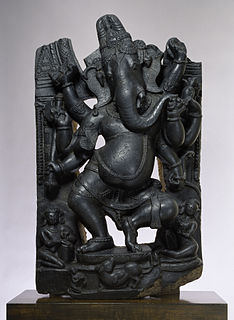
Ganapatya is a denomination of Hinduism that worships Ganesha as the Saguna Brahman.
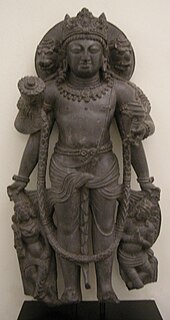
Ayudhapurusha is the anthropomorphic depiction of a divine weapon in Hindu art. Ayudhapurushas are sometimes considered as partial incarnates of their divine owners.

The Ganesha Purana is a Sanskrit text that deals with the Hindu deity Ganesha. It is an upapurāṇa that includes mythology, cosmogony, genealogy, metaphors, yoga, theology and philosophy relating to Ganesha.

The Ganapati Atharvashirsa is a Sanskrit text and a minor Upanishad of Hinduism. It is a late Upanishadic text dedicated to Ganesha, the deity representing intellect and learning. It asserts that Ganesha is same as the eternal underlying reality, Brahman. The text is attached to the Atharvaveda, and is also referred to as the Sri Ganapati Atharva Sirsha, the Ganapati Atharvashirsha, the Ganapati Atharvasirsa, or the Ganapati Upanishad.

The marital status of Ganesha varies widely in mythological stories and the issue has been the subject of considerable scholarly review. Several patterns of associations with different consorts are identifiable. One pattern of myths identifies Ganesha as an unmarried brahmacārin with no consorts. Another mainstream pattern associates him with the concepts of Buddhi (intellect), Siddhi, and Riddhi (prosperity); these qualities are sometimes personified as goddesses who are considered to be Ganesha's wives. Another pattern connects Ganesha with the goddess of culture and the arts, Sarasvati. In the Bengal region he is linked with the banana tree, Kala Bo. Usually Ganesha's consort is portrayed as his shakti, a personification of his creative energy.
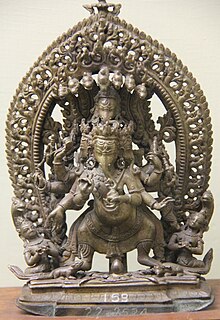
Heramba, also known as Heramba Ganapati, is a five-headed iconographical form of the Hindu god Ganesha (Ganapati). This form is particularly popular in Nepal. This form is important in Tantric worship of Ganesha. He is one of the most popular of the thirty-two forms of Ganesha.

Ganesha, also known as Ganapati and Vinayaka, is one of the best-known and most worshipped deities in the Hindu pantheon. His image is found throughout India, Nepal, Sri Lanka, Thailand, Bali (Indonesia), Malaysia, Philippines and Bangladesh and in countries with large ethnic Indian populations including Fiji, Mauritius and Trinidad and Tobago. Hindu denominations worship him regardless of affiliations. Devotion to Ganesha is widely diffused and extends to Jains and Buddhists.

Varahi is one of the Matrikas, a group of seven mother goddesses in the Hindu religion. With the head of a sow, Varahi is the shakti of Unmatta Bhairava. In Nepal, she is called Barahi.
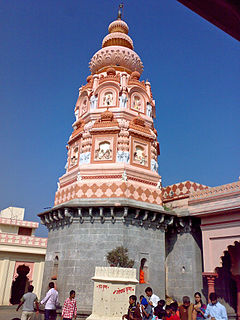
Shri Mayureshwar Mandir or Shri Moreshwar Temple is a Hindu temple (mandir) dedicated to Ganesha, god of wisdom. It is located in Moragaon in Pune District, about 65 km away from Pune city in the Indian state of Maharashtra. The temple is the starting and ending point of a pilgrimage of eight revered Ganesha temples called Ashtavinayaka.

The Chintamani Temple of Theur is a Hindu temple dedicated to Ganesha, the elephant-headed god of wisdom. Located 25 km (16 mi) from Pune, the temple is "one of the larger and more famous" of the Ashtavinayaka, the eight revered shrines of Ganesha in the Indian state of Maharashtra.

The Siddhivinayak Temple of Siddhatek is a Hindu temple dedicated to Ganesha, the elephant-headed god of wisdom. The temple is one of the Ashtavinayaka, the eight revered shrines of Ganesha in the Indian state of Maharashtra and the only Ashtavinayaka shrine in Ahmednagar district.

Gajasurasamhara, also Gajasamhara, Gajantaka and Gajaha and Matangari, is a fierce aspect of the Hindu god Shiva as the Destroyer of the elephant demon, Gajasura. The icon is popular in Pallava and Chola art, which portray him dancing vigorously in the flayed elephant hide of Gajasura.

Kangiten or Kankiten is a god in Shingon and Tendai schools of Japanese Buddhism. He is generally considered the Japanese Buddhist form of the Hindu god, Ganesha and is sometimes also identified with the bodhisattva Avalokiteshvara. He is also known as Shōten, Daishōten, Daishō Kangiten (大聖歓喜天), Tenson, Kangi Jizaiten (歓喜自在天), Shōden-sama, Binayaka-ten (毘那夜迦天), Ganapatei (誐那缽底) and Zōbiten (象鼻天).

Vināyakī is an elephant-headed Hindu goddess. Her historical and iconography are not clearly defined. Little is told about her in Hindu scriptures and very few images of this deity exist.
Vishvaksena or Vishwaksena, also known as Senai Mudalvar and Senadhipathi, is the commander-in-chief of the army of the Hindu god Vishnu and the gate-keeper and "chamberlain" of Vishnu's abode Vaikuntha. Vishvaksena is worshipped before any ritual or function in Vaikhanasas and Sri Vaishnavism sects. He occupies an important place in Vaikhanasa and Pancaratra temple traditions, where often temple festivals begin with his worship and procession.

Uchchhishta Ganapati is a Tantric aspect of the Hindu god Ganesha (Ganapati). He is the primary deity of the Uchchhishta Ganapatya sect, one of six major schools of the Ganapatyas. He is worshipped primarily by heterodox vamachara rituals. He is one of the thirty-two forms of Ganesha, frequently mentioned in devotional literature. Herambasuta was one of the exponents of the Uchchhishta Ganapatya sect.
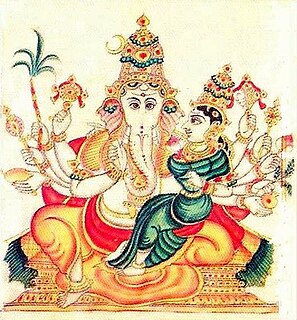
Mahaganapati, literally "Ganesha, the Great"), also spelled as Maha Ganapati, and frequently called Mahaganadhipati, is an aspect of the Hindu god Ganesha. He is the representation of Ganesha as the Supreme Being Paramatman and is the most important deity of the Ganesha-centric Ganapatya sect. He is one of the most popular of the thirty-two forms of Ganesha, worshipped as the ultimate truth Para brahman.

Bala Ganapati is an aspect of the Hindu god Ganesha (Ganapati), the elephant-headed of wisdom and fortune, depicted as a child.




















